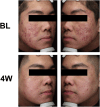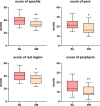Efficacy of a Postbiotic Formulation Combined With Microneedling for Mild-to-Moderate Acne: A Self-Control Study
- PMID: 39620488
- PMCID: PMC11845973
- DOI: 10.1111/jocd.16703
Efficacy of a Postbiotic Formulation Combined With Microneedling for Mild-to-Moderate Acne: A Self-Control Study
Abstract
Background: Acne vulgaris significantly affects young individuals globally, with its onset associated with an increased prevalence of C acnes, a naturally occurring skin bacterium. In light of the rising concerns regarding antibiotic resistance and the potential for adverse effects, pharmacological interventions may not consistently represent the most suitable option. Nonpharmacological approaches, such as microneedling, offer promising alternative treatment modalities. Furthermore, the integration of postbiotics in skincare formulations for acne management has gained traction recently. Nonetheless, there remains a lack of sufficient evidence to establish the efficacy and safety of postbiotics when combined with microneedling.
Objective: To assess the clinical effectiveness of a postbiotic formulation combined with microneedling in mild-to-moderate facial acne vulgaris.
Methods: Twenty Chinese patients were enrolled, all received one treatment and were monitored 4 weeks posttreatment. The evaluation assessed symptom improvement, treatment safety, and patient satisfaction.
Results: The global acne grading system (GAGS) score decreased more than half based on the baseline. Clinical photographs following treatment revealed improved the skin lesions and brightened skin tone. Statistics from VISIA showed excellent improvement in speckle, pore, red region, and porphyrin. No significant adverse reactions have been reported during the treatment period. Additionally, more than 85% were very satisfied or satisfied with the outcome.
Conclusion: Our results showed that the postbiotic formulation combined with microneedling may benefit the restoration of the skin barrier and the equilibrium of skin microbiota. This approach may help mitigate inflammation and address skin lesions, presenting a promising therapeutic avenue for the prevention and management of acne vulgaris.
Keywords: acne vulgaris; microneedling; postbiotics; skin barrier; skin microbiota.
© 2024 The Author(s). Journal of Cosmetic Dermatology published by Wiley Periodicals LLC.
Conflict of interest statement
The authors declare no conflicts of interest.
Figures





Similar articles
-
Treatment of Acne Scars with Microneedling and Chemical Reconstruction of Scarred Skin Therapy (CROSS) Using Penol/Croton Oil Combination.J Drugs Dermatol. 2024 Jun 1;23(6):418-422. doi: 10.36849/JDD.7657. J Drugs Dermatol. 2024. PMID: 38834218
-
Utility of Adding Platelet-Rich Plasma to Microneedling vs Microneedling Alone in the Treatment of Acne Scarring.J Drugs Dermatol. 2025 Jan 1;24(1):41-46. doi: 10.36849/JDD.8585. J Drugs Dermatol. 2025. PMID: 39761140 Review.
-
Evaluation and comparison of the efficacy and safety of the combination of topical phenytoin and microneedling with microneedling alone in the treatment of atrophic acne scars: A controlled blinded randomized clinical trial.Skin Res Technol. 2024 Jun;30(6):e13766. doi: 10.1111/srt.13766. Skin Res Technol. 2024. PMID: 38807440 Free PMC article. Clinical Trial.
-
Efficacy, safety, tolerability and treatment durability of microneedling plus topical tranexamic acid in combination with topical modified Kligman lightening formula for melasma: A four-arm assessor and analyst blinded randomized controlled clinical trial.J Cosmet Dermatol. 2024 Nov;23(11):3585-3597. doi: 10.1111/jocd.16464. Epub 2024 Jul 17. J Cosmet Dermatol. 2024. PMID: 39016678 Clinical Trial.
-
Radiofrequency Microneedling: A Comprehensive and Critical Review.Dermatol Surg. 2021 Jun 1;47(6):755-761. doi: 10.1097/DSS.0000000000002972. Dermatol Surg. 2021. PMID: 33577211 Review.
References
-
- Layton A. M. and Ravenscroft J., “Adolescent Acne Vulgaris: Current and Emerging Treatments,” Lancet. Child & Adolescent Health 7, no. 2 (2023): 136–144. - PubMed
-
- Moradi Tuchayi S., Makrantonaki E., Ganceviciene R., Dessinioti C., Feldman S. R., and Zouboulis C. C., “Acne Vulgaris,” Nature Reviews Disease Primers 1 (2015): 15029. - PubMed
-
- Eichenfield D. Z., Sprague J., and Eichenfield L. F., “Management of Acne Vulgaris: A Review,” Journal of the American Medical Association 326, no. 20 (2021): 2055–2067. - PubMed
MeSH terms
LinkOut - more resources
Full Text Sources
Medical

